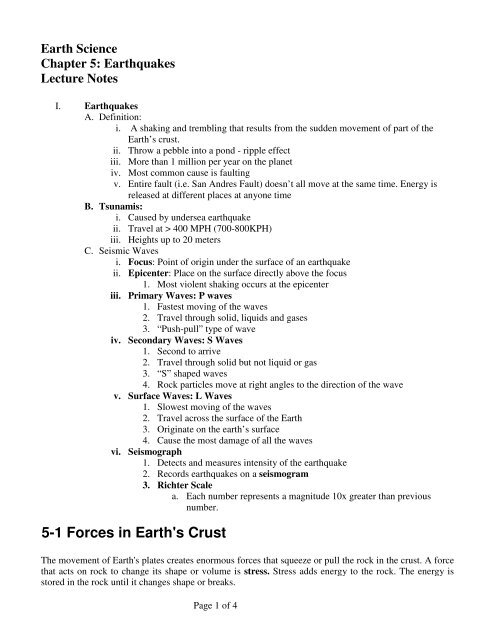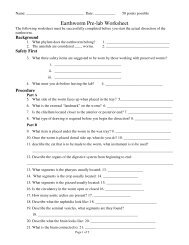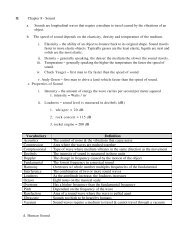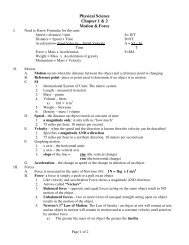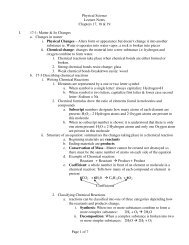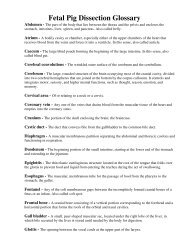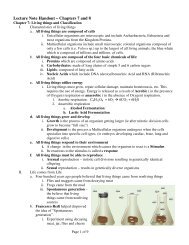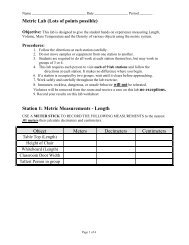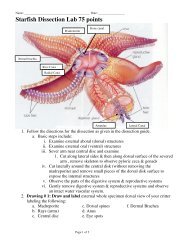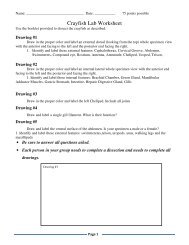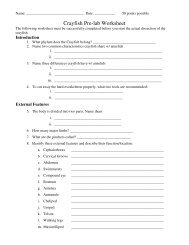5-1 Forces in Earth's Crust - Mr.E Science
5-1 Forces in Earth's Crust - Mr.E Science
5-1 Forces in Earth's Crust - Mr.E Science
Create successful ePaper yourself
Turn your PDF publications into a flip-book with our unique Google optimized e-Paper software.
Earth <strong>Science</strong><br />
Chapter 5: Earthquakes<br />
Lecture Notes<br />
I. Earthquakes<br />
A. Def<strong>in</strong>ition:<br />
i. A shak<strong>in</strong>g and trembl<strong>in</strong>g that results from the sudden movement of part of the<br />
Earth’s crust.<br />
ii. Throw a pebble <strong>in</strong>to a pond - ripple effect<br />
iii. More than 1 million per year on the planet<br />
iv. Most common cause is fault<strong>in</strong>g<br />
v. Entire fault (i.e. San Andres Fault) doesn’t all move at the same time. Energy is<br />
released at different places at anyone time<br />
B. Tsunamis:<br />
i. Caused by undersea earthquake<br />
ii. Travel at > 400 MPH (700-800KPH)<br />
iii. Heights up to 20 meters<br />
C. Seismic Waves<br />
i. Focus: Po<strong>in</strong>t of orig<strong>in</strong> under the surface of an earthquake<br />
ii. Epicenter: Place on the surface directly above the focus<br />
1. Most violent shak<strong>in</strong>g occurs at the epicenter<br />
iii. Primary Waves: P waves<br />
1. Fastest mov<strong>in</strong>g of the waves<br />
2. Travel through solid, liquids and gases<br />
3. “Push-pull” type of wave<br />
iv. Secondary Waves: S Waves<br />
1. Second to arrive<br />
2. Travel through solid but not liquid or gas<br />
3. “S” shaped waves<br />
4. Rock particles move at right angles to the direction of the wave<br />
v. Surface Waves: L Waves<br />
1. Slowest mov<strong>in</strong>g of the waves<br />
2. Travel across the surface of the Earth<br />
3. Orig<strong>in</strong>ate on the earth’s surface<br />
4. Cause the most damage of all the waves<br />
vi. Seismograph<br />
1. Detects and measures <strong>in</strong>tensity of the earthquake<br />
2. Records earthquakes on a seismogram<br />
3. Richter Scale<br />
a. Each number represents a magnitude 10x greater than previous<br />
number.<br />
5-1 <strong>Forces</strong> <strong>in</strong> <strong>Earth's</strong> <strong>Crust</strong><br />
The movement of <strong>Earth's</strong> plates creates enormous forces that squeeze or pull the rock <strong>in</strong> the crust. A force<br />
that acts on rock to change its shape or volume is stress. Stress adds energy to the rock. The energy is<br />
stored <strong>in</strong> the rock until it changes shape or breaks.<br />
Page 1 of 4
Three different k<strong>in</strong>ds of stress can occur <strong>in</strong> the crust. Tension, compression, and shear<strong>in</strong>g work<br />
over millions of years to change the shape and volume of rock. Tension pulls on the crust, stretch<strong>in</strong>g<br />
rock so that it becomes th<strong>in</strong>ner <strong>in</strong> the middle. Compression squeezes rock until it folds or breaks.<br />
Shear<strong>in</strong>g pushes a mass of rock <strong>in</strong> two opposite directions.<br />
When enough stress builds up <strong>in</strong> rock, the rock breaks, creat<strong>in</strong>g a fault. A fault is a break <strong>in</strong> the rock<br />
of the crust where rock surfaces slip past each other. Most faults occur along plate boundaries, where<br />
the forces of plate motion push or pull the crust so much that the crust breaks. There are three<br />
ma<strong>in</strong> types of faults: normal faults, reverse faults, and strike-slip faults.<br />
Tension causes a normal fault. In a normal fault, the fault is at an angle, and one block of rock lies<br />
above the fault while the other block lies below the fault. The block of rock that lies above is called the<br />
hang<strong>in</strong>g wall. The rock that lies below is called the footwall. Compression causes reverse faults. A<br />
reverse fault has the same structure as a normal fault, but the blocks move <strong>in</strong> the opposite direction.<br />
Shear<strong>in</strong>g creates strike-slip faults. In a strike-slip fault, the rocks on either side of the fault slip past each<br />
other sideways, with little up or down motion.<br />
Over millions of years, the forces of plate movement can change a flat pla<strong>in</strong> <strong>in</strong>to landforms<br />
produced by fold<strong>in</strong>g, stretch<strong>in</strong>g, and uplift<strong>in</strong>g <strong>Earth's</strong> crust. These landforms <strong>in</strong>clude anticl<strong>in</strong>es and<br />
syncl<strong>in</strong>es, folded mounta<strong>in</strong>s, fault-block mounta<strong>in</strong>s, and plateaus. A fold <strong>in</strong> rock that bends upward<br />
<strong>in</strong>to an arch is an anticl<strong>in</strong>e. A fold <strong>in</strong> rock that bends downward to form a valley is a syncl<strong>in</strong>e. Anticl<strong>in</strong>es<br />
and syncl<strong>in</strong>es are found on many parts of the <strong>Earth's</strong> surface where compression forces have folded the<br />
crust. The collision of two plates can cause compression and fold<strong>in</strong>g of the crust over a wide area. When<br />
two normal faults cut through a block of rock, fault movements may push up a fault-block mounta<strong>in</strong>. The<br />
forces that raise mounta<strong>in</strong>s can also uplift, or raise plateaus. A plateau is a large area of flat land elevated<br />
high above sea level.<br />
5-2 Earthquakes and Seismic Waves<br />
An earthquake is the shak<strong>in</strong>g that results from the movement of rock beneath <strong>Earth's</strong> surface. The area<br />
beneath <strong>Earth's</strong> surface where rock under stress breaks to cause an earthquake is called the focus. The<br />
po<strong>in</strong>t on the surface directly above the focus is called the epicenter. Dur<strong>in</strong>g an earthquake, vibrations<br />
called seismic waves move out from the focus <strong>in</strong> all directions. Seismic waves carry energy from an<br />
earthquake away from the focus, through <strong>Earth's</strong> <strong>in</strong>terior, and across the surface.<br />
There are three categories of seismic waves: P waves, S waves, and surface waves. P waves compress<br />
and expand the ground like an accordion. S waves vibrate from side to side and up and down. When P<br />
waves and S waves reach the surface, some become surface waves. Surface waves move more slowly<br />
than P waves and S waves, but they can produce severe ground movements.<br />
There are three commonly used methods of measur<strong>in</strong>g earthquakes: the Mercalli scale, the<br />
Richter scale, and the moment magnitude scale. The Mercalli scale was developed to rate earthquakes<br />
accord<strong>in</strong>g to the level of damage at a given place. An earthquake's magnitude is a number that geologists<br />
assign to an earthquake based on the earthquake's strength. The Richter scale is a rat<strong>in</strong>g of an<br />
earthquake's magnitude based on the size of the earthquake's seismic waves. The seismic waves are<br />
measured by a seismograph. A seismograph is an <strong>in</strong>strument that records and measures seismic waves.<br />
Geologists today often use the moment magnitude scale, a rat<strong>in</strong>g system that estimates the total energy<br />
released by an earthquake. An earthquake's magnitude tells geologists how much stored energy was<br />
released by the earthquake. The effects of an earthquake <strong>in</strong>crease with magnitude.<br />
Geologists use seismic waves to locate an earthquake's epicenter. When an earthquake strikes, P<br />
waves arrive at a seismograph first and S waves next. The farther away the epicenter is, the greater the<br />
difference between the two arrival times. This time difference tells scientists how far from the<br />
seismograph the epicenter is. The scientists then use the <strong>in</strong>formation from three different seismograph<br />
stations to plot circles on a map. Each circle shows the distance from one seismograph station to all the<br />
Page 2 of 4
po<strong>in</strong>ts where the epicenter could be located. The s<strong>in</strong>gle po<strong>in</strong>t where the three circles <strong>in</strong>tersect is the<br />
location of the earthquake's epicenter.<br />
5-3 Monitor<strong>in</strong>g Earthquakes<br />
Many societies have used technology to try to determ<strong>in</strong>e when and where earthquakes have occurred.<br />
Dur<strong>in</strong>g the late 1800s, scientists developed seismographs that were much more sensitive and accurate<br />
than any earlier devices. A simple seismograph can consist of a heavy weight attached to a frame by a<br />
spr<strong>in</strong>g or wire. A pen connected to the weight rests its po<strong>in</strong>t on a drum that can rotate. As the drum rotates<br />
slowly, the pen draws a straight l<strong>in</strong>e on paper that is wrapped tightly around the drum. Seismic waves<br />
cause the seismograph's drum to vibrate. But the suspended weight with the pen attached moves<br />
very little. Therefore, the pen stays <strong>in</strong> place and records the drum's vibrations. The pattern of l<strong>in</strong>es,<br />
called a seismogram, is the record of an earthquake's seismic waves produced by a seismograph.<br />
To monitor faults, geologists have developed <strong>in</strong>struments to measure changes <strong>in</strong> elevation, tilt<strong>in</strong>g<br />
of the land surface, and ground movements along faults. A tiltmeter measures tilt<strong>in</strong>g or rais<strong>in</strong>g of the<br />
ground. A creep meter uses a wire stretched across a fault to measure horizontal movement of the ground.<br />
A laser-rang<strong>in</strong>g device uses a laser beam to detect horizontal fault movements. A network of Earthorbit<strong>in</strong>g<br />
satellites called GPS (global position<strong>in</strong>g system) helps scientists monitor changes <strong>in</strong> elevation<br />
and tilt of the land as well as horizontal movement along faults.<br />
Seismographs and fault-monitor<strong>in</strong>g devices provide data used to map faults and detect changes<br />
along faults. Geologists are also try<strong>in</strong>g to use these data to develop a method of predict<strong>in</strong>g<br />
earthquakes. Geologists use the data from seismic waves to map faults, which are often hidden by a thick<br />
layer of rock or soil. This practice helps geologists determ<strong>in</strong>e the earthquake risk for an area. Geologists<br />
use fault-monitor<strong>in</strong>g devices to study the types of movement that occur along faults. Friction is the force<br />
that opposes the motion of one surface as it moves across another surface. Where friction along a fault is<br />
low, the rocks on both sides of the fault slide by each other without much stick<strong>in</strong>g. Stress does not build<br />
up, and large earthquakes are unlikely. Where friction is high, the rocks lock together. Stress builds up<br />
until an earthquake occurs. Even with data from many sources, geologists can't predict when and where a<br />
quake will strike.<br />
5-4 Earthquake Safety<br />
Geologists can determ<strong>in</strong>e earthquake risk by locat<strong>in</strong>g where faults are active, where past<br />
earthquakes have occurred, and where the most damage was caused. In the United States, the risk is<br />
highest along the Pacific Coast <strong>in</strong> the states of California, Wash<strong>in</strong>gton, and Alaska. The eastern United<br />
States generally has a low risk of earthquakes. Geologists use Mercalli scale data to produce <strong>in</strong>tensity<br />
maps. These maps show the areas most likely to suffer serious earthquake damage. Geologists also study<br />
where earthquakes have occurred <strong>in</strong> the past to help determ<strong>in</strong>e earthquake risk.<br />
Causes of earthquake damage <strong>in</strong>clude shak<strong>in</strong>g, liquefaction, aftershocks, and tsunamis. The<br />
shak<strong>in</strong>g produced by seismic waves can trigger landslides or avalanches. The types of rock and soil<br />
determ<strong>in</strong>e where and how much the ground shakes. Liquefaction occurs when an earthquake's violent<br />
shak<strong>in</strong>g suddenly turns loose, soft soil <strong>in</strong>to liquid mud. As the ground gives way, build<strong>in</strong>gs s<strong>in</strong>k and pull<br />
apart. Sometimes, build<strong>in</strong>gs weakened by an earthquake collapse dur<strong>in</strong>g an aftershock. An aftershock is<br />
an earthquake that occurs after a larger earthquake <strong>in</strong> the same area.<br />
When an earthquake jolts the ocean floor, plate movement causes the ocean floor to rise slightly and<br />
push water out of its way. The water displaced by the earthquake may form a large wave called a<br />
tsunami. A tsunami spreads out from an earthquake's epicenter and speeds across the ocean. The height<br />
of the wave is low <strong>in</strong> the open ocean, but the wave grows <strong>in</strong>to a mounta<strong>in</strong> of water as the tsunami<br />
approaches shallow water.<br />
Page 3 of 4
The ma<strong>in</strong> danger from earthquake strikes is from fall<strong>in</strong>g objects and fly<strong>in</strong>g glass. The best way to<br />
protect yourself is to drop, cover, and hold. To prepare for an earthquake, store <strong>in</strong> a convenient location<br />
an earthquake kit conta<strong>in</strong><strong>in</strong>g canned food, water, and first aid supplies.<br />
Most earthquake-related deaths and <strong>in</strong>juries result from damage to build<strong>in</strong>gs or other structures. To<br />
reduce earthquake damage, new build<strong>in</strong>gs must be made stronger and more flexible. Older<br />
build<strong>in</strong>gs may be modified to withstand stronger quakes. The way <strong>in</strong> which a build<strong>in</strong>g is constructed<br />
determ<strong>in</strong>es whether it can withstand an earthquake. A base-isolated build<strong>in</strong>g is designed to reduce the<br />
amount of energy that reaches the build<strong>in</strong>g dur<strong>in</strong>g an earthquake. Dur<strong>in</strong>g a quake, the build<strong>in</strong>g moves<br />
gently back and forth without any violent shak<strong>in</strong>g.<br />
Earthquakes can cause fire and flood<strong>in</strong>g when gas pipes and water ma<strong>in</strong>s break. Flexible jo<strong>in</strong>ts and<br />
automatic shut-off valves can be <strong>in</strong>stalled to prevent break<strong>in</strong>g and to cut off gas and water flow.<br />
Page 4 of 4


